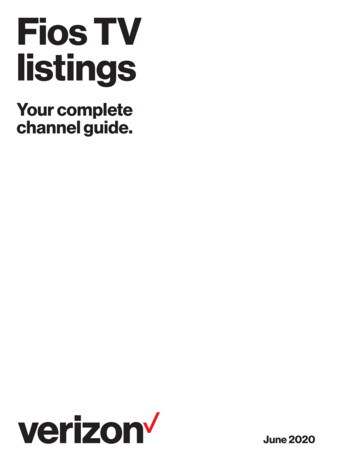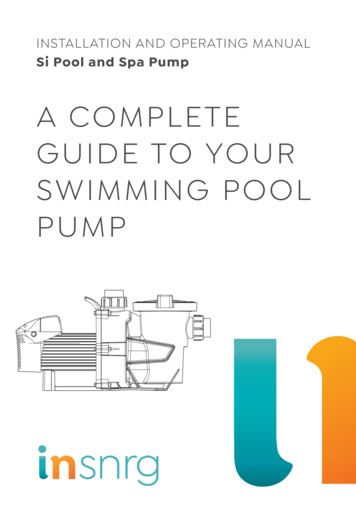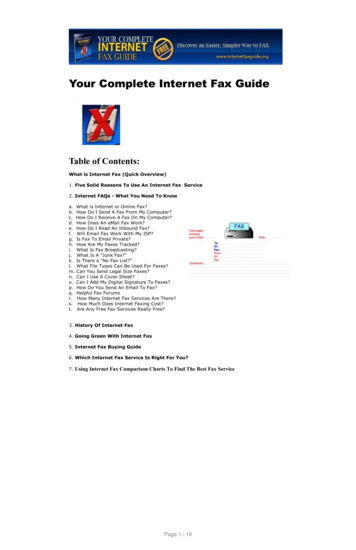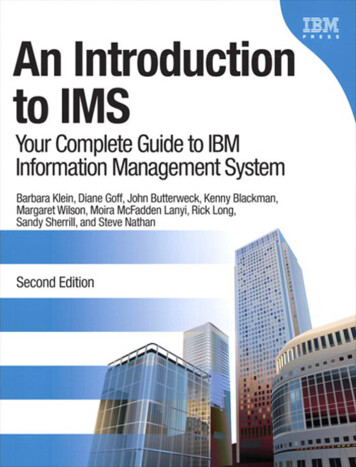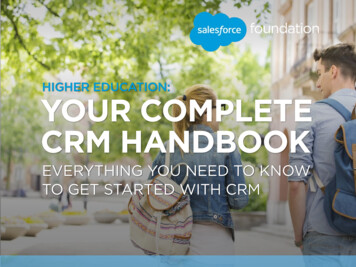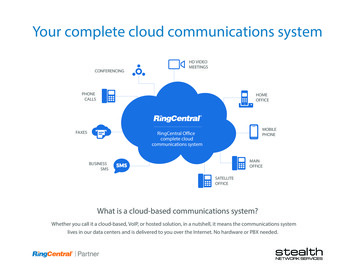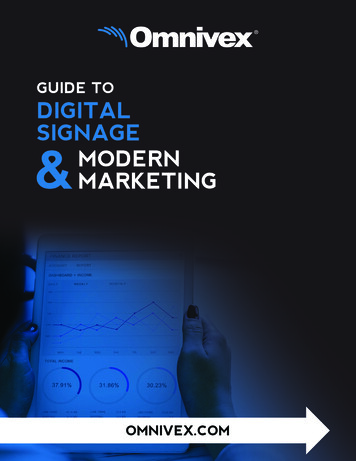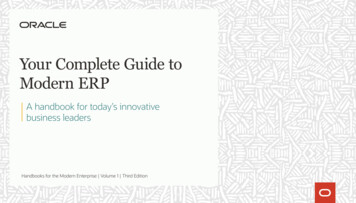
Transcription
Your Complete Guide toModern ERPA handbook for today’s innovativebusiness leadersHandbooks for the Modern Enterprise Volume 1 Third Edition
Table of ContentsOverviewChapter 4The Clear Imperative for Cloud ApplicationsAssessing Cloud ERP Results After DeploymentChapter 1Chapter 5Now Is the Right Time to Modernize Your ERPWhy Oracle Is Your Best Choice for Modern Cloud ERPChapter 2SummaryCharacteristics of Today’s Modern ERPYour Journey to Oracle Cloud Starts TodayChapter 3How Companies Deploy Modern ERP SystemsYour Complete Guide to Modern ERP2
OverviewThe Clear Imperative forCloud ApplicationsResearch shows that legacy ERP systems were not designedfor usability and insight. More than three quarters of businessleaders say their current ERP system doesn’t meet theirpresent requirements, let alone future plans. These systemslack modern best-practice capabilities you need to competeand grow. To enable today’s data-driven organization, the veryfoundation from which you’re operating needs to be re-built—itneeds to be modernized.Oracle’s goal is to help you navigate your own journey tomodernization by sharing the knowledge we’ve gainedworking with many thousands of customers who use bothlegacy and modern ERP systems. To that end, we’ve writtenthis handbook outlining the fundamental characteristics thatdefine modern ERP.Did you know?90%of large global companies willmainstream cloud computing inthree years60%of productivity-boostingopportunities during the nextdecade will be cloud-based44%of finance applicationswithin three years will bein the cloudSource: “Don’t Get Left Behind: The Business Risk and Cost of TechnologyObsolescence,” MIT Technology Review Insights, 2019.Your Complete Guide to Modern ERP3
From ERP 1.0 to ERP 2.0The rapid evolution of the cloud has dramatically altered the ERPlandscape for companies of all sizes. Coupled with mobile platforms,our work anywhere and anytime culture requires modern cloudbased ERP systems not tied to yesterday’s back-office, on-premisesenvironments. This next generation of ERP—ERP 2.0—builds on theformidable history of ERP 1.0, but eliminates the need for multiyearprojects and heavy customization.ERP 2.0 delivers solutions rapidly through the cloud soorganizations can respond quickly to volatile markets and industrydisruption while supporting next-generation employees withsecurity, insight, and mentsplanningYour Complete Guide to Modern ERP1990sBusiness-critical collaboration and decision-making depends onboth enterprise data access and analysis, and on modern ERPsystems that deliver the infrastructure and tools required to get donewhat you need.The world is far more complex and competitive than when ERP 1.0first arrived on in-house mainframes. Finance and technology areinexorably linked, as growing volumes of data drive not just operationsand reporting, but critical business decisions. Aligning ERP 2.0 witha company’s people and products delivers digitally enabled businessagility, which translates into greater operational and sales success.2000s2010sClient/server tureCloud, mobile,social, analyticsMRP IIERP 1.0 Core ERP 1.0extended with supply chain,expense management, andmore, making implementationslarger and more costlyERP 2.0 splits off functions suchas HCM and offers infrastructurefor cloud solutions to coexistERP 1.0 On-premisesenterprise resource planningdeployment with extensivecustomization of businessprocessesDigital technologies fundamentallychange how users engage withapplications4
Chapter 1Now Is the Right Time toModernize Your ERPThere’s no argument that legacy ERP 1.0 systems deliver significanthorsepower to run your organization, enable external interactions, anddirectly impact how you fare against competitors. However, you needto consider the technological and generational changes taking place inyour business and how your current on-premises environment couldbe holding you back. Regardless of business size, there are three keyinflection points where the need to modernize becomes apparent. Mostorganizations are experiencing at least one of these today.1 Operational efficiency— Does your current ERP systemsupport your operational goals? Consider if you’ve acquireda company using a different ERP system, your legacy systemis in need of an upgrade, you’re launching a subsidiary, oryou’re moving to a shared-services model. If you’re facedwith any of these scenarios, achieving operational efficiencyhas become a priority. Therefore, ERP modernization needsto be part of the conversation.Your Complete Guide to Modern ERP2 Digital transformation—Today’s users demand a levelof collaboration and ease not previously expected from onpremises solutions. In addition, their expectations for ERPsystems reflect the ubiquity of digital technology in their lives.They also require a single source of truth that cascades alloperational functions, real-time analytics with configurable rolebased dashboards, mobile access for applications, and socialcollaboration tools—all with easy and rapid regular updates.3 Growth and confidence— Growth is often synonymouswith global expansion, increasing financial complexity withdistinct accounting, reporting, and compliance requirements.Add in acquisitions, divestitures, new markets, customer growth,or IPO preparations, and the need to model these opportunitiesand their impacts requires having the right systems withprocesses in place to support increased regulatory scrutiny.Whichever inflection point describes your organization, you needa modernization strategy that fits your needs, culture, budget, andtimeline. Acknowledging where your current system does not supportyour business objectives is the first step in your ERP modernization journey.5
Top 10 signs it’s time formodern ERP 2.0You need modern ERP when one or more of theseconditions are present:5 Maintenance costs increasingERP system fees and services costs increase annually6 Unintegrated systems provide disparate dataGrowth in disconnected systems and enterprise data giveconflicting answers to key questions1 ERP upgrade required7 Rapid and global company growthYour on-premises system requires an expensive upgrade as it agespast support dates and your competitors deploy cloud solutionsInternational expansion, mergers and acquisitions, and coremarket growth are hampered by your on-premises ERP system2 Usability dissatisfaction increases8 New compliance requirementsDigital native employees complain about usability and ask why theirERP system isn’t like smartphone appsIncreasing financial and compliance requirements impactyour enterprise3 Reporting challenges increase9 Business demands increaseManagement reporting is too cumbersome because ofERP 1.0 limitationsYour business cannot keep up with increasing demands4 Requires new hardware10 Preparing for an IPOPhysical ERP 1.0 infrastructure is past due for an expensivecapital replacementYou are ready for a public offering which mandates stringentfinancial information and controlsYour Complete Guide to Modern ERP6
Chapter 2Characteristics of Today’sModern ERPNo matter which inflection point represents your organization, thereare key components of a modern ERP system that should addressthe top concerns most companies have when considering a move tothe cloud. There are seven components that fall into two categories—modern platform parameters and modern business application design.Together, these seven components define the standards of a modernERP system. To establish a foundation for agility and growth, theseplatform components should be considered.1 Security—Your business data is your business. A multilayerapproach to securing data at every layer of the stack is paramountfor maximum data protection. Using a secure data isolationarchitecture in the cloud reduces risk and enables faster data accessand processing.2 Integration— ERP cloud solutions must seamlessly connect yourbusiness, people, and processes. Your solution must also connect toother clouds, to your on-premises systems, and to third-party solutions.To ensure compatibility and scalability you should choose a solutionthat uses a common framework based on industry standards.Your Complete Guide to Modern ERP3 Personalization (not customization)—With ERP 1.0,nonstandard or customer-specific business practices resultedin customizations that increased downstream maintenance andupgrade challenges. Cloud-based solutions built on a standardsbased platform offer personalization and configuration withinthe application, resulting in “upgrade-safe” enhancements.If your on-premises customizations fall into areas such asworkflows, integrations, and reporting, there’s a good chance yourrequirements can be addressed by cloud-based solutions.In addition, modern cloud applications should scale with your businessand support the latest digital technologies to meet your organization’sneeds. These apps should have the following design components:4 Completeness—Built-in best practices permitstandardization, which lowers costs and increases productivity.Even if your cloud transition is incremental, access to a completesuite of integrated best-practice business processes deliversenterprise standardization. Consider whether a cloud ERP vendorsupports a full suite of applications or if integration to other cloudsolutions will be required. If you initially select a hybrid cloud/onpremises model—a common operational option—who ensuresintegrations between on-premises and cloud applications?7
5 Globalization—Entering emerging markets andnew geographies creates complexity by requiring any ERPcloud solution to support multiple subsidiaries and countrylocalizations. Often, local data centers must comply with dataresidency requirements. The right cloud ERP must enablesharing of enterprise information seamlessly across operations,business units, and headquarters.6 Insight-driven analysis—An cloud ERP solution musthave secure, real-time data access at its financials core toprovide a single source of truth across roles, reports, andanalysis. This ensures timely delivery of accurate KPIs tofront-line managers, and dramatically simplifies a processonce dependent on a period close or a separate datawarehouse extract.7 Digital capabilities— For the modern back office, digitaltechnologies must be integrated into business processes andtransactions to create a seamless, productive, and intuitiveexperience. The user experience needs to be engaging andinclude mobile accessibility for on-the-go employees, nativesocial integration for secure in-context collaboration, and outof-the-box optical character recognition for invoice imaging.On-premises ERP 1.0 vscloud ERP 2.0These are the top five reasons for moving from ERP 1.0 to ERP 2.0:45%38%33%33%24%Avoid infrastructureinvestmentLower TCOAvoid on-premisesupgrade projectRapid access to newERP functionalityOne source of datawith a global viewSources: “The End of Technology Obsolescence,” MIT Technology ReviewInsights, 2019, and “ERP Trends,” Oracle, 2018.Your Complete Guide to Modern ERP8
Chapter 33 Get strong executive sponsorship— Regardless ofHow Companies DeployModern ERP Systemscompany size, executive sponsorship is critical. You needcontinuous executive support throughout your entireproject. Coupled with ongoing employee communication,leadership commitment to your new cloud ERP system willhelp drive success.As you plan your modern ERP strategy, you should pull together adeployment team that includes potential implementation partnersas well as cloud providers. Consider the following elements of amodernization strategy, which apply regardless of technology andmarket size.4 Select an implementation approach aligned tothe organization—A migration to cloud ERP will vary by1 Clearly define project goals— Establish KPIs that measurebusiness benefits such as productivity, financial close speed, andinfrastructure costs. Measurable items help you to build projectconsensus and approval, align to your strategy, and provide abaseline to assess success at milestones.customer, and does not require deploying all cloudERP applications at once. Many companies choose toincrementally adopt high-value cloud services that will existalongside their on-premises solutions, resulting in a hybridenvironment. Other companies start a modernizationjourney with core ERP applications, building towards acomplete end-to-end transformation.2 Document processes and inventory systems— Mapyour complete IT infrastructure, including internal and thirdparty solutions and their integration points, plus redundantsystems. Include your organizational structure to understandroles in conjunction with data ownership, management, anduse. It’s also critical to define a single source of truth beforestarting your project.Your Complete Guide to Modern ERPHow to cloud—A five-stepsuccess guideLearn More9
5 Embrace standard best practices built intothe application—Modern best practices are built into cloudapplications, so you can replace legacy software along withoutdated processes and approaches. ERP 2.0 delivers morethan 80% of common business processes you need with built-instandardization—the perfect place to start your project.6 Study reporting and analytics early—With cloudERP, users understand your business in real time. Advancedmultidimensional analysis and data visualization provide insightsquickly without a data warehouse. Define reporting and analyticsearly in the project plan. Once live, you can quickly generatemeaningful reports.7 Involve users and process owners from the start— Endusers of ERP systems determine the success of your project.Throughout your implementation, include demonstrations andtrials at regular intervals.With your strategy and roadmap in place, solution choices made,and a partner who supports your vision, you’re ready toexecute. Now it is ti
Modern ERP Systems As you plan your modern ERP strategy, you should pull together a deployment team that includes potential implementation partners as well as cloud providers. Consider the following elements of a modernization strategy, which apply regardless of technology and market size.

